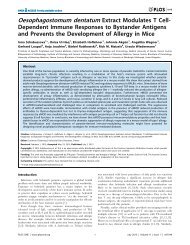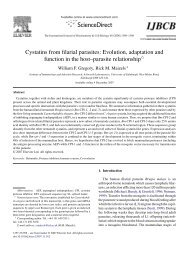Experimental Parasitology - Rick Maizels' Group - University of ...
Experimental Parasitology - Rick Maizels' Group - University of ...
Experimental Parasitology - Rick Maizels' Group - University of ...
You also want an ePaper? Increase the reach of your titles
YUMPU automatically turns print PDFs into web optimized ePapers that Google loves.
Prowse, et al., 1979), although they have also been regarded as sites <strong>of</strong> tissue remodelling that<br />
may follow parasite exit (Sugawara, et al., 2011) and can persist long after worm expulsion<br />
(Cywinska, et al., 2004). More recent studies have shown that intestinal granulomas are foci <strong>of</strong><br />
alternatively activated macrophages (Anthony, et al., 2006, Sugawara, et al., 2011), as well as<br />
granulocytes (Morimoto, et al., 2004) induced by IL-4 and/or IL-13-dependent IL-4Rα signalling.<br />
It is possible that differing cellular compositions within the intestinal granulomas, and/or the<br />
rate at which cell infiltration proceeds relative to maturation <strong>of</strong> the larva, are critical factors in<br />
whether parasite killing can occur within the tissue.<br />
Intestinal granuloma macrophages expressing alternatively activated macrophage products<br />
Arginase-1, RELM-α and Ym1, also develop following primary infection <strong>of</strong> genetically resistant<br />
SJL mice (Filbey, K.J. et al., manuscript in preparation), while in more susceptible BALB/c<br />
animals granuloma numbers inversely correlate with worm burdens (Reynolds, L. A. et al.,<br />
unpublished data). In fact, clodronate-mediated depletion <strong>of</strong> macrophages reduces this<br />
granulomatous inflammation and protective immunity in response to both primary and<br />
secondary infection (Anthony, et al., 2006 and Filbey, K. J. et al, manuscript in preparation).<br />
Even if larvae are not killed within granulomas, however, they may incur immune damage that<br />
compromises their subsequent growth and reproduction following emergence into the lumen.<br />
Although CD4 + T cells mediate helminth immunity during primary infection, there is also an<br />
essential role <strong>of</strong> antibodies, particularly during recurrent infection. Thus, passive transfer <strong>of</strong><br />
immune antibodies can reduce worm length and fecundity, even if numbers <strong>of</strong> live worms are<br />
little altered (McCoy, et al., 2008, Liu, et al., 2010). Innate effector cells also participate, as IL-<br />
4/-13-stimulated intestinal epithelial cells differentiate into goblet cells, increase mucin<br />
production (Hasnain, et al., 2011) and release RELM-β, a natural defence molecule with directly<br />
inhibitory effects on adult H. polygurus worms (Herbert, et al., 2009). A summary <strong>of</strong> these<br />
mechanisms is presented in Figure 2.<br />
Immune regulation in vivo<br />
The primary immune response to H. polygyrus infection has a predominant Th2 response<br />
phenotype (Wahid, et al., 1994, Mohrs, et al., 2005), but is accompanied by regulatory T cell<br />
activation (Metwali, et al., 2006, Finney, et al., 2007, Setiawan, et al., 2007, Rausch, et al.,<br />
2008) and fails to achieve parasite expulsion in all but the most genetically-resistant strains<br />
(Prowse, et al., 1979). However, susceptible mice are able to mount highly effective immunity if<br />
exposed to a short-term (14-day) infection curtailed by curative drug-treatment (Behnke and<br />
Wakelin, 1977, Anthony, et al., 2007). As protective mechanisms exist but are not stimulated or<br />
Maizels et al Hydra Special Issue Page 5





